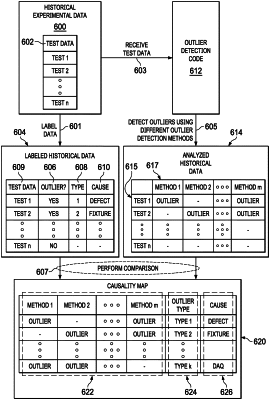| CPC G05B 19/41865 (2013.01) [G05B 19/4183 (2013.01); G05B 19/41885 (2013.01); G06F 18/2433 (2023.01)] | 23 Claims |

|
1. A method for managing a set of outliers in test data, the method comprising a computer system:
analyzing, using different outlier detection methods, a set of standard features comprising the test data and identify outliers in the standard features, wherein the test data is obtained from testing a physical structure;
deriving, using governing physics of a potential problem of the physical structure and applying derivative or integral transformation to a portion of the test data, transformed features comprising features underlying the potential problem;
analyzing, using the different outlier detection methods, the transformed features and identifying outliers in the transformed features;
selecting, using the governing physics of the potential problem, data from at least one of the test data or the transformed features and forming selected features; and;
analyzing, using the different outlier detection methods, the selected features and identifying outliers in the selected features;
aggregating: the outliers in the standard features, the outliers in the transformed features, and the outliers in the selected features, into the set of outliers in the test data;
correlating a type of outlier revealed by each outlier detection method in the different outlier detection methods for each of: the standard features, the transformed features, and the selected features;
using a causality map, derived from historical data from testing structures, associating types of outliers and their causes with a number of different outlier detection methods;
subsequently determining, using the causality map, a causality for the set of outliers in the test data; and
retesting the physical structure with a set of changes determined using the causality identified for the set of outliers, wherein the retesting generates new test data for the physical structure.
|